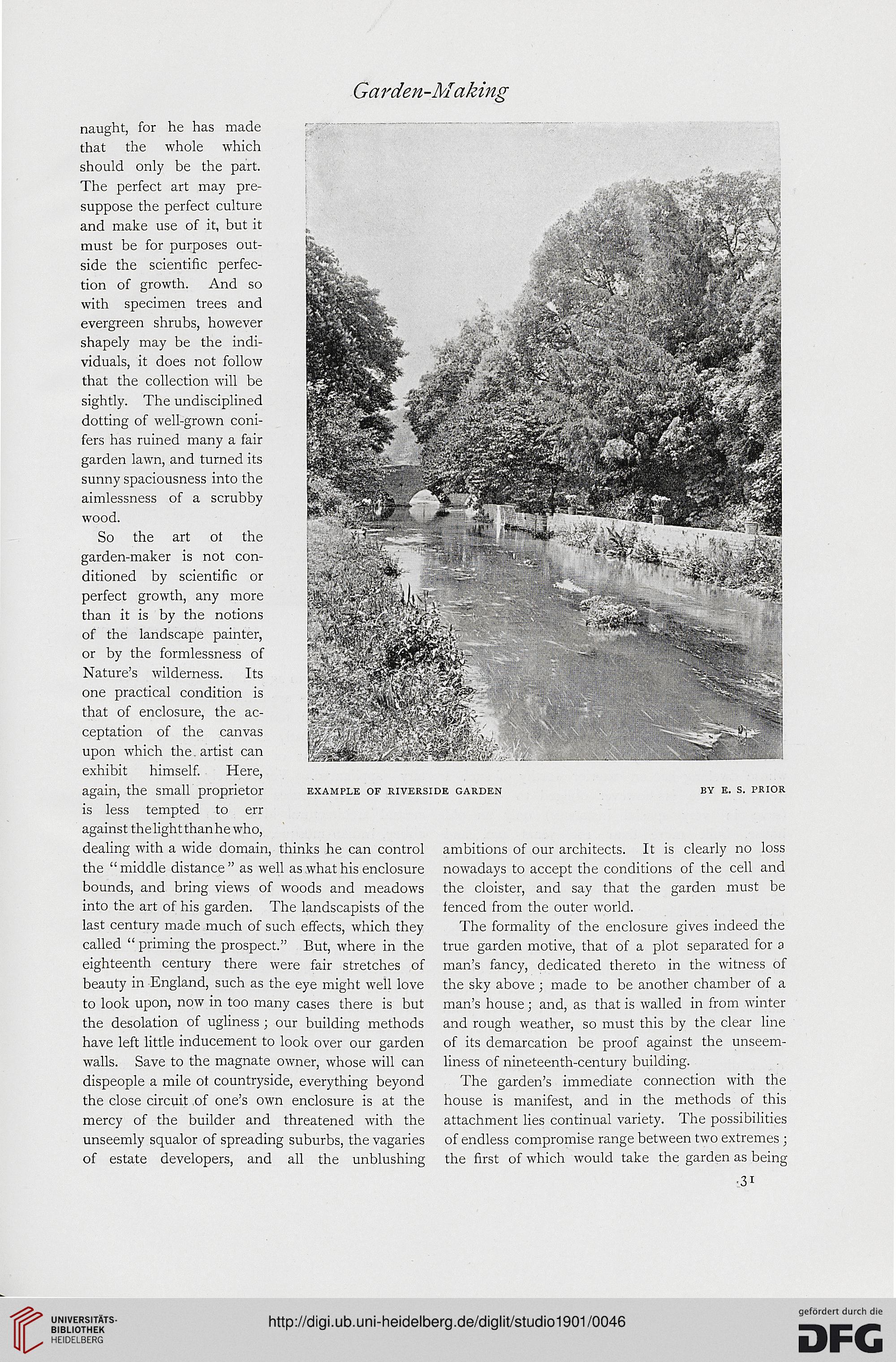Garden-Making
naught, for he has made
that the whole which
should only be the part.
The perfect art may pre-
suppose the perfect culture
and make use of it, but it
must be for purposes out-
side the scientific perfec-
tion of growth. And so
with specimen trees and
evergreen shrubs, however
shapely may be the indi-
viduals, it does not follow
that the collection will be
sightly. The undisciplined
dotting of well-grown coni-
fers has ruined many a fair
garden lawn, and turned its
sunny spaciousness into the
aimlessness of a scrubby
wood.
So the art ot the
garden-maker is not con-
ditioned by scientific or
perfect growth, any more
than it is by the notions
of the landscape painter,
or by the formlessness of
Nature's wilderness. Its
one practical condition is
that of enclosure, the ac-
ceptation of the canvas
upon which the. artist can
exhibit himself. Here,
again, the small proprietor example of riverside garden by e. s. prior
is less tempted to err
against thelightthanhe who,
dealing with a wide domain, thinks he can control ambitions of our architects. It is clearly no loss
the "middle distance" as well as what his enclosure nowadays to accept the conditions of the cell and
bounds, and bring views of woods and meadows the cloister, and say that the garden must be
into the art of his garden. The landscapists of the fenced from the outer world.
last century made much of such effects, which they The formality of the enclosure gives indeed the
called " priming the prospect." But, where in the true garden motive, that of a plot separated for a
eighteenth century there were fair stretches of man's fancy, dedicated thereto in the witness of
beauty in England, such as the eye might well love the sky above ; made to be another chamber of a
to look upon, now in too many cases there is but man's house; and, as that is walled in from winter
the desolation of ugliness ; our building methods and rough weather, so must this by the clear line
have left little inducement to look over our garden of its demarcation be proof against the unseem-
walls. Save to the magnate owner, whose will can liness of nineteenth-century building,
dispeople a mile ot countryside, everything beyond The garden's immediate connection with the
the close circuit of one's own enclosure is at the house is manifest, and in the methods of this
mercy of the builder and threatened with the attachment lies continual variety. The possibilities
unseemly squalor of spreading suburbs, the vagaries of endless compromise range between two extremes ;
of estate developers, and all the unblushing the first of which would take the garden as being
3i
naught, for he has made
that the whole which
should only be the part.
The perfect art may pre-
suppose the perfect culture
and make use of it, but it
must be for purposes out-
side the scientific perfec-
tion of growth. And so
with specimen trees and
evergreen shrubs, however
shapely may be the indi-
viduals, it does not follow
that the collection will be
sightly. The undisciplined
dotting of well-grown coni-
fers has ruined many a fair
garden lawn, and turned its
sunny spaciousness into the
aimlessness of a scrubby
wood.
So the art ot the
garden-maker is not con-
ditioned by scientific or
perfect growth, any more
than it is by the notions
of the landscape painter,
or by the formlessness of
Nature's wilderness. Its
one practical condition is
that of enclosure, the ac-
ceptation of the canvas
upon which the. artist can
exhibit himself. Here,
again, the small proprietor example of riverside garden by e. s. prior
is less tempted to err
against thelightthanhe who,
dealing with a wide domain, thinks he can control ambitions of our architects. It is clearly no loss
the "middle distance" as well as what his enclosure nowadays to accept the conditions of the cell and
bounds, and bring views of woods and meadows the cloister, and say that the garden must be
into the art of his garden. The landscapists of the fenced from the outer world.
last century made much of such effects, which they The formality of the enclosure gives indeed the
called " priming the prospect." But, where in the true garden motive, that of a plot separated for a
eighteenth century there were fair stretches of man's fancy, dedicated thereto in the witness of
beauty in England, such as the eye might well love the sky above ; made to be another chamber of a
to look upon, now in too many cases there is but man's house; and, as that is walled in from winter
the desolation of ugliness ; our building methods and rough weather, so must this by the clear line
have left little inducement to look over our garden of its demarcation be proof against the unseem-
walls. Save to the magnate owner, whose will can liness of nineteenth-century building,
dispeople a mile ot countryside, everything beyond The garden's immediate connection with the
the close circuit of one's own enclosure is at the house is manifest, and in the methods of this
mercy of the builder and threatened with the attachment lies continual variety. The possibilities
unseemly squalor of spreading suburbs, the vagaries of endless compromise range between two extremes ;
of estate developers, and all the unblushing the first of which would take the garden as being
3i




